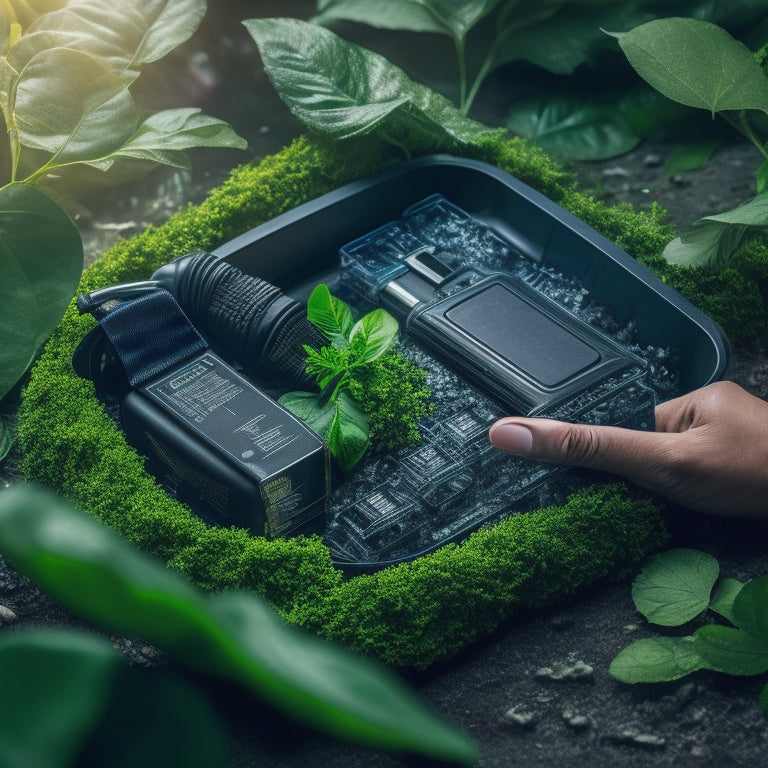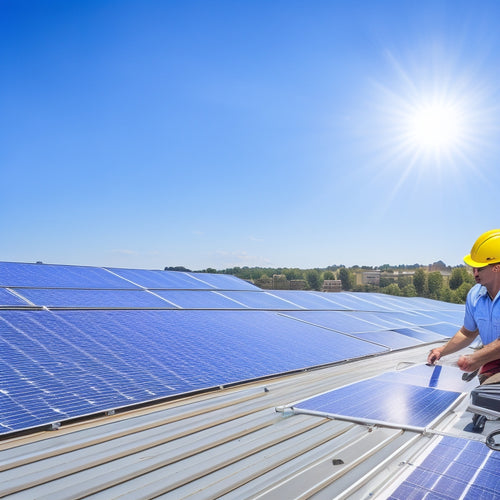
Recycle EV Batteries Sustainably: A Step-by-Step Guide
Share
You're about to take an essential step in sustainable transportation: recycling your electric vehicle's (EV) batteries. This process will reduce waste, conserve natural resources, and mitigate the environmental costs of primary material extraction. To recycle EV batteries sustainably, you'll need to collect and store used batteries safely, then disassemble them to extract valuable materials like lithium, cobalt, and nickel. You'll learn how to identify hazardous materials, separate battery components, and repurpose battery management systems. As you move forward, you'll discover the recycling benefits and sustainable loop closure that comes with responsible EV battery recycling, and realize the full potential of this eco-friendly approach.
Key Takeaways
• Implement battery collection methods like swap stations and drop-off points to gather used batteries efficiently.
• Prioritize safe storage practices, such as storing batteries away from heat sources and ensuring electrical precautions.
• Disassemble EV battery packs carefully to extract individual cells, noting cell configuration and thermal management systems.
• Segregate components like cells, modules, and materials to maximize material recovery and minimize waste.
• Recycling EV batteries conserves resources, reduces waste, and mitigates environmental impacts like water pollution and land degradation.
Understanding EV Battery Chemistry
As you explore the world of EV battery recycling, understanding the fundamental chemistry behind these batteries becomes essential. You'll discover that electric vehicles rely on rechargeable batteries, which store energy through electrochemical reactions. These reactions occur between positive electrodes (cathodes) and negative electrodes (anodes), separated by an electrolyte. The type of battery chemistry used in EVs is typically lithium-ion, which offers high energy densities.
Energy densities are important in EV batteries, as they directly impact the vehicle's range and performance. A higher energy density means more energy can be stored per unit of battery weight and volume. Lithium-ion batteries excel in this regard, with energy densities exceeding 250 Wh/kg.
This is made possible by the electrochemical reactions that occur during charging and discharging. When you charge your EV, lithium ions move from the cathode to the anode, releasing energy. During discharge, the process reverses, and the ions move back to the cathode, generating electricity. Understanding these electrochemical reactions is crucial for developing efficient recycling methods that can recover valuable materials like lithium, nickel, and cobalt.
Collecting and Storing Used Batteries
As you set out to collect and store used EV batteries, you'll need to contemplate the methods you'll use to gather these batteries, guarantee they're stored safely, and designate areas for storage that won't harm the environment.
You'll want to explore various collection methods, such as take-back programs, community drop-off points, and partnerships with repair shops, to name a few.
Battery Collection Methods
You'll need to establish a well-organized battery collection system to efficiently gather and store used electric vehicle (EV) batteries, ensuring a seamless recycling process. This involves implementing effective collection methods that encourage public participation and facilitate the return of spent batteries.
One strategy is to set up battery swap stations, allowing EV owners to conveniently exchange their depleted batteries for new ones. This approach not only promotes a closed-loop system but also fosters community engagement, as it raises awareness about the importance of sustainable battery recycling.
Additionally, partnering with local businesses, schools, and community centers can help create a network of drop-off points, making it easier for individuals to participate in the recycling process. By implementing these collection methods, you'll be able to gather a substantial quantity of used batteries, paving the way for a successful recycling program.
Safe Storage Practices
When collecting and storing used EV batteries, it's important to follow safe storage practices to prevent fires, explosions, and environmental contamination, which can have devastating consequences if not handled properly.
You must prioritize fire safety by storing batteries away from heat sources and flammable materials. Make sure electrical precautions are taken by keeping batteries away from electrical sources and ensuring proper grounding.
A well-planned storage layout is critical, with batteries stored in a way that prevents them from touching each other or other conductive materials. Access control is also important, restricting access to authorized personnel only.
Climate regulation is key, maintaining a consistent temperature between 32°F and 80°F (0°C and 27°C) to prevent thermal runaway.
Finally, implement an inventory management system to track battery condition, type, and storage location. This will help you identify potential hazards and take corrective action.
Designated Storage Areas
To guarantee the safe and efficient collection and storage of used EV batteries, designate a specific area for storage, taking into account the battery type, size, and condition. This designated storage area will help secure, reduce the risk of fires, and ensure a smoother recycling process.
When setting up your storage area, consider the following key factors:
-
Secure Racking: Invest in sturdy, fire-resistant racking systems that can hold the batteries securely, preventing them from toppling over or coming into contact with each other.
-
Climate Control: Maintain a consistent, moderate temperature (between 60°F to 80°F) to prevent overheating, which can lead to thermal runaway.
-
Ventilation: Ensure good airflow to remove any gases that may be emitted by the batteries.
- Accessibility: Organize the storage area to allow for easy access and retrieval of batteries, making it simpler to sort and transport them for recycling.
Disassembling EV Battery Packs
As you begin disassembling EV battery packs, you'll need to carefully extract individual modules, employing techniques that minimize damage to valuable components.
Next, you'll remove cells from their housings, taking care to preserve their integrity for further processing.
Battery Module Disassembly
You'll typically begin disassembling an EV battery pack by removing the module enclosures, which house the battery modules, to access the individual cells. This pivotal step requires careful planning and execution to safeguard the integrity of the cells and the environment. Module design plays a significant role in this process, as it dictates the complexity of the disassembly process.
To facilitate efficient disassembly, you'll need the right disassembly tools, including:
- Torque wrenches for removing bolts and screws
- Pliers and screwdrivers for manipulating connectors and cables
- Safety gloves and goggles for protecting yourself from electrical and mechanical hazards
- A clean, well-ventilated workspace to minimize environmental impact
As you disassemble the module, take note of the cell configuration, wiring, and thermal management systems. This information will be essential for subsequent steps in the recycling process.
Remember to handle the cells with care, as they contain hazardous materials that require special handling and disposal. By following these guidelines, you'll be well on your way to sustainable battery recycling.
Cell Removal Techniques
With the module enclosures removed, you're now ready to extract the individual cells, which demands a meticulous approach to prevent damage and guarantee safe handling of the hazardous materials. This process, known as cell dismantling, requires attention to detail to prevent electrical shorts or physical damage to the cells.
| Cell Type | Dismantling Technique | Precautions |
|---|---|---|
| Prismatic | Carefully remove cell from module using specialized tools | Avoid applying excessive force, which can cause cell deformation |
| Pouch | Gently peel away adhesive layers, taking care not to puncture the cell | Ensure a clean and dry environment to prevent contamination |
| Cylindrical | Use a cell cracker or specialized pliers to carefully release the cell | Wear protective gear, including gloves and safety glasses |
During this process, conducting a battery autopsy is crucial to identify any defects or anomalies that may have contributed to the battery's end-of-life. By following a structured approach to cell removal, you'll guarantee the safe and efficient extraction of valuable materials for recycling.
Component Segregation Methods
Disassemble the EV battery pack into its constituent components, separating the cells, modules, and other materials to facilitate efficient recycling and minimize waste. This vital step guarantees that each component can be properly processed and recycled, reducing the risk of contamination and maximizing the recovery of valuable materials.
To achieve effective component segregation, you'll need to:
-
Identify and separate the different types of cells, such as lithium-ion, nickel-cadmium, or lead-acid, for targeted recycling
-
Remove and categorize the various modules, including electrical connections, thermal management systems, and structural components
-
Isolate and sort the diverse materials, including metals, plastics, and electronics, for specialized recycling and processing
- Utilize automated processing systems and material sorting technologies to streamline the segregation process and enhance efficiency
Identifying Valuable Battery Materials
Identifying the valuable materials within EV batteries is essential, as it enables recyclers to extract and process high-value components like lithium, nickel, and cobalt. As you explore the recycling process, you'll need to determine the material composition of the batteries you're working with. This involves material sourcing, where you'll assess the type and quality of the battery cells.
Next, you'll conduct a chemical analysis to identify the exact chemical composition of the battery materials. This step is vital, as it allows you to pinpoint the valuable materials and optimize the extraction process. You'll need to analyze the chemical properties of the battery cells, including the electrolyte, cathode, and anode materials.
Separating Battery Cell Components
You'll now separate the battery cell components, carefully extracting the various parts to recover valuable materials and minimize waste. This step is essential in the recycling process, as it allows you to identify and isolate the various components that make up the battery cell.
To achieve this, you'll employ cellular disassembly techniques, which involve dismantling the battery cell into its constituent parts. This includes the positive electrode (cathode), negative electrode (anode), electrolyte, and separator.
Some key steps to focus on during this process include:
-
Carefully disassembling the battery cell to prevent damage to the components
-
Identifying and separating the different materials, such as plastics, metals, and electrolytes
-
Conducting electrochemical analysis to determine the chemical composition of the battery cell
- Documenting the process and results to refine your recycling methodology
Extracting Lithium and Cobalt
As you move forward with recycling EV batteries, you'll need to focus on extracting lithium and cobalt, two essential components with significant environmental and economic implications.
You'll explore various lithium extraction methods, each with its own strengths and weaknesses, to maximize yields while minimizing waste.
Next, you'll examine the cobalt recovery process, a vital step in reclaiming this valuable resource and reducing the industry's ecological footprint.
Lithium Extraction Methods
Lithium extraction from spent EV batteries typically involves hydrometallurgical or pyrometallurgical processes to break down the battery's cathode materials and separate the lithium and cobalt. You'll find that these methods are essential in recovering valuable materials and reducing the environmental impact of Lithium Mining.
As you explore the process, you'll realize that electrochemical processing plays an important role in extracting lithium.
Here are some key aspects to keep in mind in lithium extraction:
-
Mechanical separation: Crush and sort the battery materials to isolate the cathode and anode.
-
Leaching: Use chemical solutions to dissolve the lithium and cobalt, making them easier to extract.
-
Solvent extraction: Separate the lithium and cobalt using selective solvents that target specific ions.
- Electrochemical processing: Employ electrolysis to refine the extracted lithium, producing high-purity lithium compounds.
Cobalt Recovery Process
With the lithium extraction methods in place, your focus now shifts to the cobalt recovery process, which involves a series of steps to separate and refine cobalt alongside lithium. This process is critical, as cobalt toxicity poses significant environmental and health risks if not handled properly. The cobalt recovery process involves several stages, including crushing, grinding, and magnetic separation to isolate cobalt-rich fractions.
| Step | Description |
|---|---|
| 1. Crushing and grinding | Reduce particle size to increase surface area for separation |
| 2. Magnetic separation | Use magnetic forces to separate cobalt-rich particles from lithium-rich particles |
| 3. Chemical refining | Treat cobalt-rich particles with chemicals to produce high-purity cobalt |
Repurposing Battery Management Systems
You'll need to rethink the entire Battery Management System (BMS) when repurposing electric vehicle (EV) batteries, since the original design wasn't intended for secondary uses. The BMS is a complex system that monitors and controls the battery's state of charge, voltage, and temperature. To repurpose it, you'll need to reassess its functionality and adapt it to the new application.
When repurposing the BMS, consider the following key aspects:
-
System Integration: Guarantee seamless communication between the BMS and other components in the new system.
-
Energy Harvesting: Optimize the BMS to efficiently manage energy storage and release.
-
Cell Balancing: Adjust the BMS to balance the state of charge across cells, preventing overcharge or undercharge.
- Monitoring and Control: Refine the BMS to provide real-time monitoring and control of the battery's performance.
Recycling Battery Cell Materials
As the electric vehicle (EV) battery reaches its end-of-life, extracting valuable materials from the spent cells becomes an essential step in reducing electronic waste and supporting a circular economy.
You'll be extracting materials like lithium, cobalt, nickel, and graphite, which can be reused in new battery production. This not only reduces the demand for primary materials but also helps minimize the environmental impact of mining.
By recycling these materials, you'll be reducing greenhouse gas emissions and conserving natural resources.
Recycling battery cell materials also offers significant economic benefits. You can recover up to 95% of the materials in a lithium-ion battery, which can be resold or reused in new products. This closed-loop system helps reduce production costs and increases the overall efficiency of the battery supply chain.
Moreover, recycling creates new job opportunities and stimulates local economies. By embracing sustainable recycling practices, you'll be supporting a more environmentally conscious and economically viable future for the EV industry.
Properly Disposing of Hazardous Waste
Disposing of hazardous waste from spent EV batteries requires meticulous attention to environmental regulations and safety protocols to prevent toxic leaks and contamination. You must make certain that you're handling hazardous materials responsibly, minimizing the risk of environmental harm and human exposure.
To achieve this, follow these essential steps for proper disposal:
-
Segregate hazardous materials: Separate hazardous waste from non-hazardous materials to prevent cross-contamination.
-
Use appropriate containers: Store hazardous waste in specially designed containers that prevent leakage and are labeled accordingly.
-
Comply with regulations: Familiarize yourself with local, national, and international regulations governing hazardous waste disposal, such as the Basel Convention.
- Partner with certified facilities: Collaborate with facilities certified to handle hazardous waste, ensuring that they adhere to stringent environmental and safety standards.
Closing the Sustainable Loop
What role can recycling play in closing the sustainability loop for EV batteries, and how can it mitigate the environmental impacts of mining and processing primary materials? By recycling EV batteries, you're not only reducing waste but also decreasing the demand for primary materials, which are often extracted and processed at significant environmental costs.
| Material | Primary Production Impact | Recycling Benefit |
|---|---|---|
| Lithium | Water pollution, land degradation | Conserves water, reduces land use |
| Cobalt | Child labor, mining accidents | Reduces mining accidents, promotes fair labor |
| Nickel | Deforestation, air pollution | Preserves forests, reduces air pollution |
| Graphite | Water pollution, energy consumption | Conserves water, reduces energy consumption |
| Copper | Energy consumption, water pollution | Reduces energy consumption, conserves water |
Frequently Asked Questions
Can I Recycle EV Batteries at Home Safely?
As you ponder recycling EV batteries at home, beware: it's a ticking time bomb. Without proper personal protection, you risk toxic exposure. Don't let household disposal turn into a hazardous nightmare – it's not worth the risk; seek professional guidance instead.
How Much Does EV Battery Recycling Cost Typically?
You'll find that EV battery recycling costs vary, but on average, it's around $1-2 per pound, depending on the type and quality of the battery. Industry standards are emerging, making cost comparison vital for sustainable practices.
Are Recycled EV Battery Materials as Good as New Ones?
You're wondering if recycled EV battery materials measure up to new ones. Rest assured, recycled materials often match new ones in material quality, with some studies showing comparable performance, making sustainable recycling a viable, eco-friendly option.
Can I Sell My Used EV Battery to a Recycling Facility?
'Oh, you want to cash in on your used EV battery? Think of it as a hot commodity! You can sell it to a recycling facility, but first, take a Facility Tour to make sure they're not just dumping it. Then, put it up for a Battery Auction – just don't get too charged up about the price.'
Are There Any Government Incentives for Recycling EV Batteries?
You'll be happy to know that yes, there are government incentives for recycling EV batteries, including tax credit incentives and a developing regulatory framework that supports sustainable recycling practices, encouraging you to take the eco-friendly route.
Related Posts
-

What Does Solar Panel Maintenance Really Cost?
You can expect to pay between $1,500 to $2,500 per year for solar panel maintenance, with costs influenced by your sy...
-

Best Online Solar Panel Systems for Small Homes
When choosing the best online solar panel system for your small home, consider top-rated brands like SunPower, Panaso...
-

5 Essential Tips for Your DIY Home Solar System
To guarantee a successful DIY home solar system installation, you'll need to assess your energy consumption, choosing...


